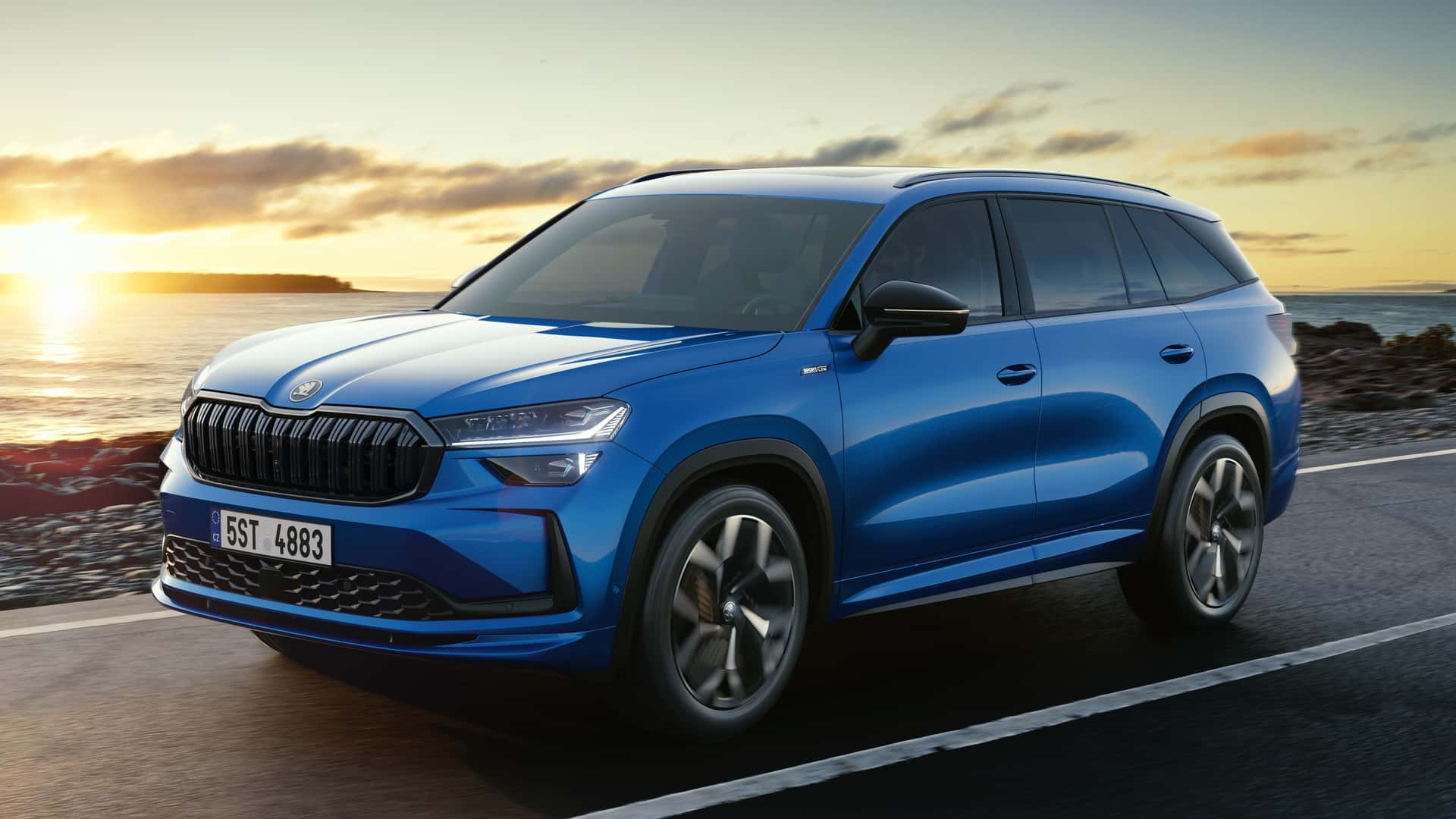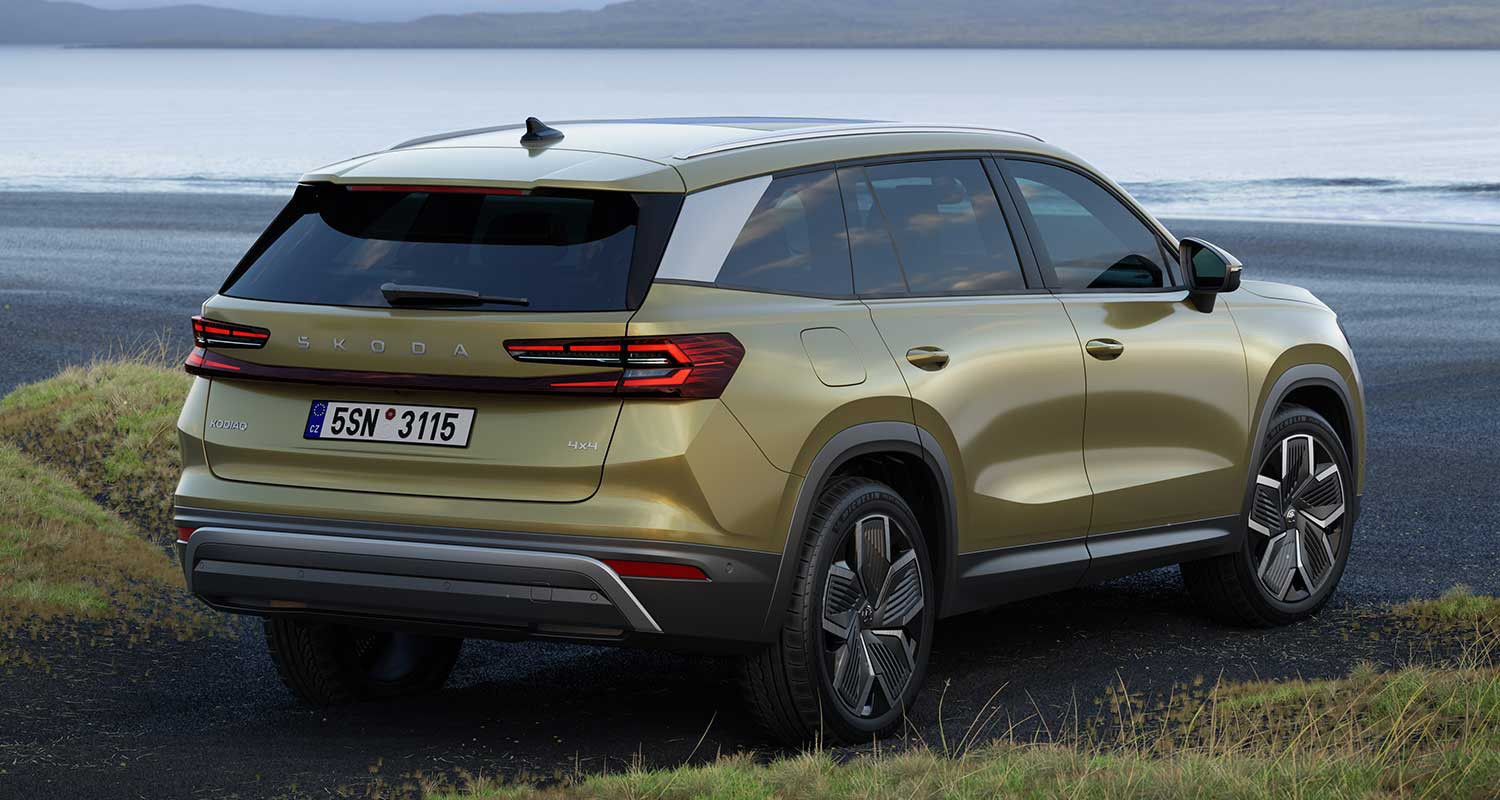The Kodiaq was first introduced in 2017 as Skoda’s biggest vehicle, a large and chunky SUV with seats for seven and, way back when it was first launched, a temptingly low price point. Unsurprisingly, given its versatility and practicality, the Kodiaq went on to become a big seller for Skoda, occasionally being the brand’s best-selling model on the Irish market.
Now, there’s a new one on sale. The new Kodiaq looks and, to an extent, feels like an all-new model but actually it’s a new body and interior on top of the same core mechanical package as the old one. So, under the new clothes there’s the familiar Volkswagen Group ‘MQB’ platform, with diesel and petrol engines carried over too. Unlike the original Kodiaq, this one comes with seven seats as standard in Ireland, except for in the new plug-in hybrid model, which has only five seats as the battery takes up too much space.
The styling is clearly an evolution of that of the previous Kodiaq, albeit with softer lines that appear to give the car a sleeker profile. There’s a distinctive contrast-coloured roof pillar at the back, and up front a wider, lower grille and slimmer headlights. It’s still obviously a Kodiaq, but one which is wearing a slimmer-fitting suit.
This time around, though, the Kodiaq is being pitched very much as a premium product, with pricing to match.
Back in 2017, the original Kodiaq seemed tantalisingly affordable with a circa-€30,000 starting price, but the cheapest of the new models will set you back €53,970. That gets you a Selection model powered by a 2.0 TDI diesel engine sending its 150hp to the front wheels through a standard-fit seven-speed DSG automatic gearbox.
For €54,680 you can upgrade to a ‘mild-hybrid’ 1.5-litre petrol engine, again with front-wheel drive, up to 150hp and the same automatic transmission. There’s a 190hp version of the diesel engine with four-wheel drive as standard as well, and that costs from €62,170. Or there’s the new plug-in hybrid (PHEV), which has an official electric range of 100km on a full charge of its hybrid battery - that costs from €57,890 in Selection form.
Selection spec includes driver attention alert, a hill-hold system, electronic child safety locks, seven airbags, all-round vehicle monitoring with driver assistance (which can slam on the brakes if it detects you’re about to hit something), adaptive cruise control, keyless entry and ignition, a 10.4-inch touchscreen infotainment system, wireless Apple CarPlay and Android Auto, dual-wireless phone charging pad, three-zone climate control, digital instruments, front and rear parking sensors, a reversing camera, an electric tailgate, ambient cabin lighting, heated front seats, electric driver seat adjustment and 18-inch alloy wheels.
The new Kodiaq range only comes with two specifications so far, so the only upgrade possible is to the Selection+ model, which is the one we’re test-driving here. With the basic petrol engine that’ll cost you €61,295, or with the 150hp diesel, as evaluated here, that’s going to be €59,370 before options (our test car came with €5,044 worth of extras, including 20-inch alloy wheels, a ‘Technology Pack’ with a larger touchscreen and a panoramic glass sunroof). The 190hp TDI 4x4 model costs €67,570 in Selection+ form, while the plug-in hybrid is €65,575.
Among the equipment upgrades in Selection+ trim are leather upholstery in either black or ‘Cognac’ (a rather fetching shade of brown), 19-inch alloy wheels, Matrix LED headlights, dynamic rear indicators, tinted privacy glass and anodised roof rails.
Skoda Ireland currently offers the Kodiaq with a 3.9 per cent APR PCP finance package, with monthly repayments starting at €409, but check out https://www.skoda.ie/finance-offers/finance-offers for the most up-to-date offers.
Interior Design and Features
As with the exterior, the Kodiaq’s interior seems initially familiar, but once you get in there and start poking around, you realise it’s really quite different. The dashboard is a bit more sculpted than before and has less of the cliff-face effect of the old car’s, but it still looks and feels substantial. We’ve tried two Kodiaqs now, one with plain black upholstery and one with the Cognac brown leather and you should definitely go for the Cognac, as it adds a feeling of genuine luxury. The seats themselves are hugely comfortable and supportive, and the high-up driving position helps cancel out the blind spot caused by the chunky windscreen pillars.
The big screen and digital dials we’ll deal with in the next section, but what really strikes you about the Kodiaq is the sheer amount of space on offer. In the front, there’s a huge storage area in the centre console, with adjustable cupholders and a double-deck space which houses both the wireless phone chargers and another useful shelf. There’s a sliding cover for the centre console too, so you can cover up any valuables. Under the front-seat armrest, there’s a large storage box, and there are two glove boxes - one upper and one lower - which are hugely useful.
Interior Space
In the back seats, there is an almost staggering amount of space, with acres of legroom even for tall passengers sat behind tall drivers, and plenty of headroom too, even with the optional glass roof stealing a few mm of vertical space. The rear seats also split-fold in 60:40 formation, and slide back and forth too, so you can balance legroom between the middle and third rows.
It’s in the third row that the Kodiaq’s space odyssey becomes unstuck, just a touch. The extra seats in the boot are easy enough to flip up or down, but in terms of actual room, they’re really only suitable for children - and quite small children at that. Legroom and foot space in the third row means that it’s a no-go zone for anyone much over the age of 12.
Fold those seats away, and there’s a massive 845-litre boot up to the luggage cover, with a van-like 2,000 litres if you fold down all the back seats. The boot comes with a selection of hooks, a 12-volt power socket and little dividing panels that affix to the floor with Velcro so that you can separate, say, muddy sports gear from fresh shopping. There’s some useful under-floor storage too, where you’ll find a ‘spacesaver’ spare wheel, and a slot into which the retracting luggage blind can go when you want to get all the seats folded down. As ever with Skoda, there are also some helpful touches such as an umbrella in the driver’s door, and an ice-scraper which clips into the fuel flap.
Tech and Infotainment
As standard, the Kodiaq comes with a 10-inch touchscreen infotainment system, but our test car had been upgraded to the 13-inch screen. Skoda uses its latest software to run the screen, and there are some distinct improvements over what went before, not least in the menu structure and on-screen layout which are simpler and easier to understand than they used to be.
The screen upgrade also comes with a native navigation system (of dubious use now that everyone has Google Maps on their phones...) and connected online services, which are packaged with a three-year subscription for the online connection. Skoda also fits the Kodiaq with five USB-C sockets - two each for the front and rear, and an extra one in the rear-view mirror housing.
What really helps, in terms of the touchscreen, are the three little physical rotary dials on the dashboard, referred to as ‘Smart Dials’ by Skoda. These control the cabin temperature and the stereo volume or, at a press of the little screens built into the centre of the controls, the fan speed or the seat heating. They’re a neat little idea, which takes a lot of the operational strain off the touchscreen, and which are simple and easy to use when you’re driving. Our only complaint is that they feel a little too loose-limbed when you use them - they could do with a more high-quality feel.
The big digital instrument screen behind the two-spoke steering wheel is pleasantly useful, although not what you’d call ground-breaking. You can adjust the information displayed on the screen, the general layout and ‘theme’ with the buttons (proper, physical buttons, hurrah!) on the steering wheel.
Safety and Practicality
If you’re using ISOFIX child car seats, then the Kodiaq has three sets of mounting points - two in the middle row of seats, and one in the front passenger seat. Slightly disappointingly, there are no ISOFIX points in the folding third row of seats, but you can of course fit seats back there using the seatbelts. Significantly, the middle row of seats is just about wide enough to comfortably fit an adult sitting between two child seats.
It probably won’t come as a surprise that the Kodiaq scored well on the Euro NCAP tests with a full five-star score with an 89 per cent rating for adult occupant protection, 83 per cent for child occupants, 82 per cent for vulnerable road user protection and 78 per cent for its electronic safety systems.
Driving the Kodiaq
As with the safety rating, there’s not much in the way of a surprise here. The Kodiaq is mostly smooth and easy to drive, and even though it’s a big and bulky car, it doesn’t feel overly massive from behind the wheel.
With 150hp and 360Nm from the 2.0-litre TDI diesel engine, performance isn’t really the Kodiaq’s strong suit, but it never feels slow, and to be honest there’s not a huge advantage to upgrading to the 190hp 4x4 version aside from the added traction as both feel like they have pretty similar real-world performance. The seven-speed DSG automatic gearbox has had its selector moved up to the steering column, so you simply twist forward for go, and backwards for reverse. As before, this gearbox can be rather hesitant at times, taking a second longer to react than is ideal, especially in urban situations.
At low speeds, around town, the Kodiaq’s ride quality is a bit too firm at times, although in fairness our test car was fitted with the optional 20-inch alloy wheels. Sticking with the standard 18-inch rims might cure that issue. The steering is light and fairly direct, and that extends to how the Kodiaq drives on the open road. Yes, it’s big and heavy, but again it never feels unwieldy. If you’re being very pernickety, you might notice a slight sense of slack and vagueness in the steering and the suspension compared to the more all-together feel of the earlier Kodiaq, but few owners will notice that. Equally, if you go for the 190hp 4x4 version, there’s enough ground clearance to allow the Kodiaq to tackle some properly rough roads and terrain, but again it’s not likely that many owners will ever actually do that.
What the Kodiaq Does Best
What the Kodiaq does best is eat up the kilometres of a long journey. There is a bit too much tyre roar on coarse surfaces (possibly again due to the larger tyres fitted to our car), but aside from that the Kodiaq is refined, comfortable and smooth, while the adaptive cruise control and useful lane-keeping steering take the sting out of long motorway runs.
Skoda Ireland’s deal with fuel-supplier Certa means that the Kodiaq, as with all other current diesel-engined Skodas, is designed to run on HVO - Hydrogenated Vegetable Oil - just as easily as it is conventional diesel. This recycled and upcycled cooking oil is a diesel substitute, which is claimed to have 90 per cent lower CO2 emissions than fossil-fuel-based diesel. That claim has been contested by some, but it does at least feel like an ‘every little helps’ thing for those who need the convenience and long range of a diesel engine but are conscious of their carbon output.
Our average fuel consumption, mixing some long motorway drives with shorter urban runs, worked out at 7.0 litres per 100km, well above the official 5.7 litres per 100km figure. The 148g/km CO2 emissions figure means you’ll only pay €270 a year in motor tax, which is hardly punitive.
The Verdict
The Kodiaq is as the Kodiaq was. Although its price has ballooned to the point where it’s perilously easy to spec-up a €70,000+ Kodiaq, this is still a hugely impressive family-friendly seven-seat SUV, with lots of space, tremendous practicality and a gorgeous interior.
If there’s anything about the Kodiaq we’ve not covered, or you’d like help in choosing between it and other vehicles, you can avail of our (completely free) expert advice service via the Ask Us Anything page.


















